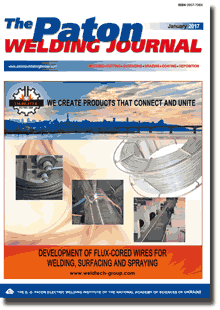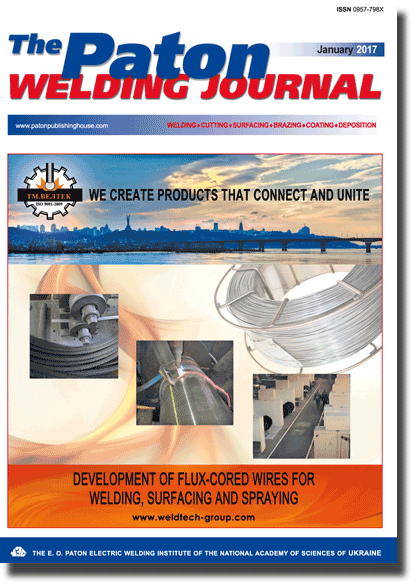| 2017 №01 (13) |
DOI of Article 10.15407/tpwj2017.01.01 |
2017 №01 (02) |

The Paton Welding Journal, 2017, #1, 2-9 pages
Effect of binder type on manufacturability and properties of E-08Kh20N9G2B type coated electrodes
K.A. Yushchenko, A.V. Bulat, N.V. Skorina, A.E. Marchenko, V.I. Samojlenko and N.Yu. Kakhovsky
E.O. Paton Electric Welding Institute, NASU 11 Kazimir Malevich Str., 03680, Kiev, Ukraine. E-mail: office@paton.kiev.ua
Abstract
The results of investigations of the properties of electrode compounds, coatings and electrodes of rutile-basic type were set forth and analyzed. These electrodes are designed for welding of high-strength Cr–Ni steels depending on composition of lithium-containing liquid glass. It is shown that application of Li–Na–K liquid glass for manufacture of such electrodes allows significantly improving their hygiene and sanitary properties due to reduction of specific emissions of hexavalent chromium high-toxic compounds. Simultaneously, application of Li–Na–K glass results in significant decrease of hygrosorption capacity of the coating, at that its strength and crack resistance in welding do not deteriorate, and ductility and impact toughness of weld metal is somewhat improved. The workability indices and welding-technological characteristics of compared electrodes are at the same level. The results of the investigations allowed upgrading coating composition and production technology of ANV-35 electrodes. 23 Ref., 9 Tables, 2 Figures.
Keywords: high-alloy Cr–Ni steels, arc welding, coated electrodes, binders, processing characteristics of electrode compounds, strength and hygroscopic properties of electrode coatings, welding-technological and hygienic properties of electrodes, composition and structure of deposited metal, mechanical properties of weld metal
Received: 16.02.17
Published: 04.07.16
References
- Pokhodnya, I.K., Gorpenyuk, V.N., Milichenko, S.S. et al. (1990) Metallurgy of arc welding: processes in arc and melting of electrodes. Kiev: Naukova Dumka.
- Pokhodnya, I.K., Yavdoshchin, I.R., Gubenya, I.P. (2011) Welding fume – factors of influence, physical properties and methods of analysis (Review). The Paton Welding J., 6, 33–36.
- GOST 12.1.007–76 SS BT: Harmful substances. Classification and general safety requirements. Introd. 01.01.1977.
- Yushchenko, K.A., Levchenko, O.G., Bulat, A.V. et al. (2007) Sanitary and hygienic characteristics of covered electrodes for welding high-alloy steels. The Paton Welding J., 12, 35–38.
- Levchenko, O.G., Bulat, A.V., Bezushko, O.M. (2010) Influence of electrode coating on hygienic characteristics of fumes, formed in welding of high-alloy steels. Visnyk NT UU KPI. Seriya Girnytstvo, Issue 19, 171–177.
- Kawada, K., Kobayashi, M. Experimental investigations on hazard of lithium in welding fume. IIW Doc. VIII-286–79.
- Kimura, I., Kobayashi, M., Godai, T. et al. (1979) Investigations on chromium in stainless steel welding fume. Welding Res. Suppl., 8, 195–204.
- Astrom, H. (1993) Advanced development techniques for coated electrodes. Welding Rev. Int., 12(2), 72, 74, 76.
- Griffiths, T., Stevenson, A. (1989) Binder developments for stainless electrodes. Welding Rev., 8(3), 192, 194, 196.
- Inobond. Special silicates for welding consumables. Company brochure Van Baerle, Switzerland.
- A new generation of stainless steel MMA electrodes. Company brochure AirLiquide/Oerlikon.
- Marchenko, A.E. (1978) About rheological methods for evaluation of technological properties of electrode compounds. Information of CMEA. Coordination Center on problems: Development of scientific basics and new technological processes of welding, surfacing and thermal cutting of materials and alloys for manufacturing of welded structures and development of efficient welding consumables and equipment, Issue 1(13), 121–128.
- Marchenko, A.E. (2010) On physical-chemical nature of strength of electrode coatings and technological means of its ensuring. In: of 5th Int. Conf. on Welding Consumables, Technologies, Manufacturing, Quality and Competitiveness (Artyomovsk–Kiev, Ukraine, 2010), 78–99.
- Pokhodnya, I.K., Ofengenden, R.G., Gorpenyuk, V.N. et al. (1979) Information-measuring system for investigation of technological properties of welding consumables, equipment and processes. Svarka, 10, 67–68.
- Sidlin, Z.A., Tarlinsky, V.D. (1984) Current types of coated electrodes and their application for arc welding. Moscow: Mashinostroenie.
- Lipodaev, V.N., Bojko, Yu.N., Kakhovsky, Yu.N. et al. Method of evaluation of slag crust detachability. USSR author’s cert. 407689. Publ. 28.08.1973.
- Kalinyuk, V.V. (2011) Organizing of analysis process for titanium alloys on oxygen, nitrogen, hydrogen and carbon content. Metrologiya ta Prylady, 2, 50.
- MU 1927–78: Guidelines. Hygienic evaluation of welding consumables and methods of welding, surfacing and cutting of metals. Moscow: Minzdrav SSSR, 1980.
- MU 4945–88: Guidelines on determination of harmful substances in welding fume (solid phase and gases). Minzdrav SSSR, 1990.
- Slania, J., Slazak, B. (2006) Badania porownawcze electrod otulonych wysokostopowych ERWS 19-9 L productowanych przy zastosowaniu nowego szkla wodnego modyficowanego tlenkiem litu. Instytutu Spawalnictwa, 6, 48–53.
- Rudneva, A.V., Model, M.S. (1963) Phase transformations during reduction of titanium dioxide in slag systems. Izvestiya AN SSSR. Metallurgiya i Gornoe Delo, 1, 59.
- Marchenko, A.E., Skorina, N.V., Kiselev, M.O. (2010) Evolution of concept on nature and properties of liquid glass, being important in manufacture of welding electrodes. In: of Int. Conf. on Welding Consumables: Technologies, Manufacturing, Quality, Competitiveness (Agoj, 7–10 June 2010). Kiev: PWI, 2010, 100–106.
- Perminov, A.A., Popel, S.I., Smirnov, N.S. (1961) Influence of replacement of nitrogen oxide by oxides of other metals on surface tension of silicate melts and their adhesion to hard steel. Izvestiya Vuzov. Chyorn. Metallurgiya, 12, 5–8.
Suggested Citation
K.A. Yushchenko, A.V. Bulat, N.V. Skorina, A.E. Marchenko, V.I. Samojlenko and N.Yu. Kakhovsky (2017) Effect of binder type on manufacturability and properties of E-08Kh20N9G2B type coated electrodes. The Paton Welding J., 01, 2-9.The cost of subscription/purchase order journals or individual articles
| Journal/Currency | Annual Set | 1 issue printed |
1 issue |
one article |
| TPWJ/USD | 384 $ | 32 $ | 26 $ | 13 $ |
| TPWJ/EUR | 348 € | 29 € | 24 € | 12 € |
| TPWJ/UAH | 7200 UAH | 600 UAH | 600 UAH | 280 UAH |
| AS/UAH | 1800 UAH | 300 UAH | 300 UAH | 150 UAH |
| AS/USD | 192 $ | 32 $ | 26 $ | 13 $ |
| AS/EUR | 180 € | 30 € | 25 € | 12 € |
| SEM/UAH | 1200 UAH | 300 UAH | 300 UAH | 150 UAH |
| SEM/USD | 128 $ | 32 $ | 26 $ | 13 $ |
| SEM/EUR | 120 € | 30 € | 25 € | 12 € |
| TDNK/UAH | 1200 UAH | 300 UAH | 300 UAH | 150 UAH |
| TDNK/USD | 128 $ | 32 $ | 26 $ | 13 $ |
| TDNK/EUR | 120 € | 30 € | 25 € | 15 € |
AS = «Automatic Welding» - 6 issues per year;
TPWJ = «PATON WELDING JOURNAL» - 12 issues per year;
SEM = «Electrometallurgy Today» - 4 issues per year;
TDNK = «Technical Diagnostics and Non-Destructive Testing» - 4 issues per year.


